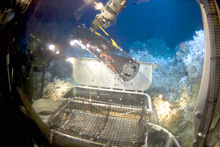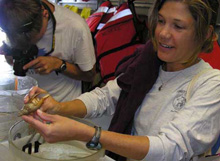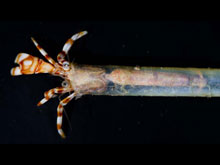
The sub's manipulator arm collecting a crab trap containing five Galatheid crabs. Click image for larger view and image credit.
Ground Truth on the Ocean Bottom
October 18, 2005
Bob Schwartz
Web Coordinator
NOAA Public Affairs
Today's dives were in a new area off Cape Lookout approximately 12 nautical miles south of yesterday's sites, in about 1200' to 1400' of water. The team has never visited this area before and, prior to the dives, only had topographical data on it via sonar. According to Dr. Ross, a critical advantage of submersible diving is the capability of collecting direct data that he refers to as ground truthing. "Ground truthing is a visual characterization of what is there. 'Ground' means that you're getting there and 'truth' means you're saying what's there. Ground truthing is critical if you want to do habitat work. Otherwise, you're just stuck with topography. We've got lots of topography, but we don't know what's on it," he said.
Other methods of characterizing the ocean bottom, such as sonar, trawling and bottom grabs, do provide essential information, applicable in many respects. However, for the exploration and research being conducted by Dr. Ross, a more direct method of observation is preferred. Submersible diving aboard the Johnson Sea-Link allows explorers and scientists to go where they want to go and see, first hand, what is happening on the bottom. For Dr. Ross, it allows habitat and faunal characterization on a smaller scale with more precise control of sampling than with other methods. On the first dive of the day, the team investigated a new ridge (well, new to us), previously identified via a depth sounder survey in 2001. Prior to that, coral banks in this area weren't marked and nobody knew how large this coral bank system was. The goal was to investigate the bottom and work their way up the mound to its peak. Strong currents prevented them from reaching the peak, but they did discover some areas of very dense coral development, lots of ridges and mounds that ran up approximately 150 to 200 feet from the base. It was a rugged habitat with a lot of dead coral but also plenty of live coral as well as fish and invertebrates, including a species of fish only seen by the team a few times before. During this dive it was confirmed that this area is home to a very large coral bank system.During the second dive, the explorers followed about the same track of the first dive, continued past it and investigated the mound's peak. The reason they targeted the peak is because that's where they find the highest concentration of coral. Dr. Ross explains: "Generally, these corals like strong currents. So the taller the ridge, the more the ridge itself affects the current and increases the speed as the current tries to go over the ridge. So the corals are often concentrated on the tops of these peaks more so than in other places," he said. Dr. Ross described the area as spectacular. They collected samples, including another specimen of Chaunax sp. similar to the one collected yesterday 12 miles north. Another achievement of the afternoon dive was the first successful use of a Galatheid crab trap they had been testing. Baited with mullet heads and cat food, this trap is made of metal and tough plastic mesh and looks like a cylindrical version of a standard crab or lobster trap.. but they've never gotten it to work before tonight. The crabs simply crawled around it rather than going inside. In an impromptu brainstorming session, the suggestion was made that maybe too much scent from the bait was coming through the mesh and not enough out the ends. To test the hypothesis, they wrapped the trap in a shower curtain. They reasoned that doing so would only allow the scent to come out from the desired openings. To everyone's delight, their reasoning bore fruit tonight as the trap caught five Galatheid crabs. As I'm writing this, Andrea Quattrini is out in the wetlab building another trap. Both will be deployed again tomorrow. Innovative thinking is definitely the name of the game when it comes to fishing, and that's no exception out here.
Life on the Edge will be sending daily reports from Oct 16 - Nov 4. Please check back frequently for additional logs from this expedition.
Sign up for the Ocean Explorer E-mail Update List.



























